Special Section
Retirement Guide 2016
Opening the door to the next stage in life means choosing the right housing option.
By By Rebecca Kirkman | Photography by Mitro Hood — April 2016
We’ve all seen the demographic bubble coming: The last of the baby-boomer generation turned 50 in 2014, meaning there’s now a large group of people nearing retirement or, at the very least, thinking about how they’d like to live the next decade or two. But this isn’t a group that’s going to go quietly to the old folks’ home.
The good news? Baltimore was ranked the seventh best city in the nation for a healthy and affordable retirement in a 2015 study by insurance company Bankers Life. (Washington, D.C., placed 54th.) We scored high marks for our world-class health care systems, including The Johns Hopkins Hospital and University of Maryland Medical Center, ranked high for a large and social senior population, and got points for our many historical attractions.
So whether you’re an empty nester looking to trade in a large property in the county for an upscale urban apartment or a frequent traveler looking for the flexibility and security that a midtown condo provides, Baltimore has a variety of options for the over-55 crowd.
Baby boomers are rethinking what it means to be retired, with many choosing an active, urban lifestyle. And that often means close proximity to cultural and culinary attractions, perhaps to a continuing job, or maybe to family——but without the headaches of maintaining a large property.
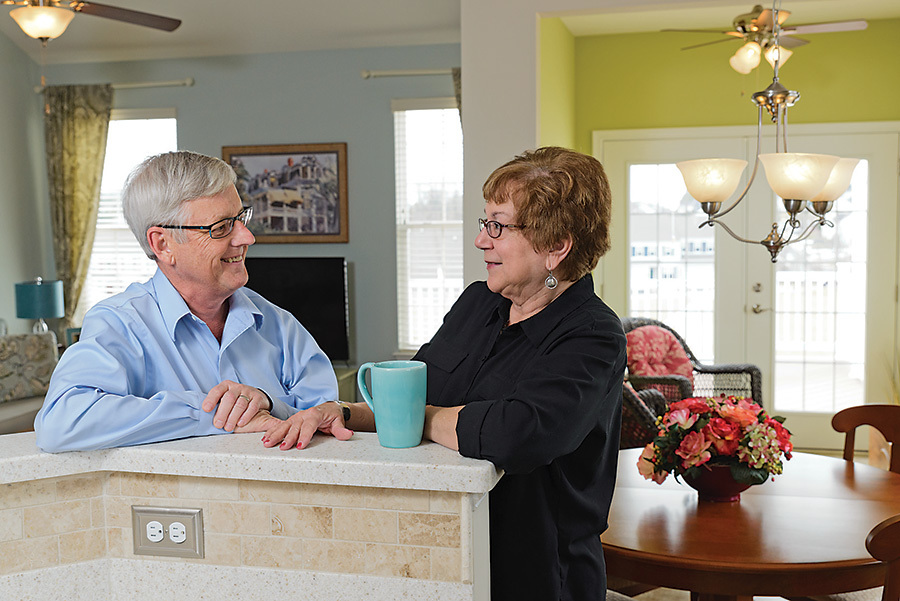
A Worry-Free Community with a View
“We have a neighborhood now,” declares Robin Nawrot with a smile. In the spring of 2014, Robin and her husband, Ron, moved to Greenvale Mews, an over-55 community of attached villas in Westminster. Built to include a fishing pond and walking trails with the peace and quiet of a rural area, the community is just minutes away from shopping, dining, entertainment, and medical facilities. The space of a single-family home—think extra storage and a two-car garage—combined with the convenience of condominium living attracted the Nawrots to the development.
The couple’s longtime ranch home just south of the Maryland-Pennsylvania border was down a three-quarter mile gravel road and surrounded by farmland. “We knew we were going to move eventually because we couldn’t keep taking care of the property,” she says. Nawrot discovered plans for the Greenvale Mews development while researching retirement options for a friend, and its benefits lingered in the back of her mind when the couple first started thinking about what they wanted in a move.
The Nawrots didn’t plan to end up in an over-55 community. “When we were writing down a list of wants, my husband said, ‘We are absolutely not moving to an over-55 community,’” she remembers. “And then when he thought about it, he said, ‘You’re right, there’s no reason not to go there’,” she recalls, pointing out that some college-aged children do live in the community with their parents. It’s truly an active community, says Nawrot, where residents are “out there walking around, riding bikes—we have a man across the street who runs every day.” Most of all, the “over-55” requirement just brings together like-minded people. “We have similar interests, we are of somewhat similar ages. Some are working, some aren’t,” says Nawrot. “It’s been interesting getting to know the neighbors.”
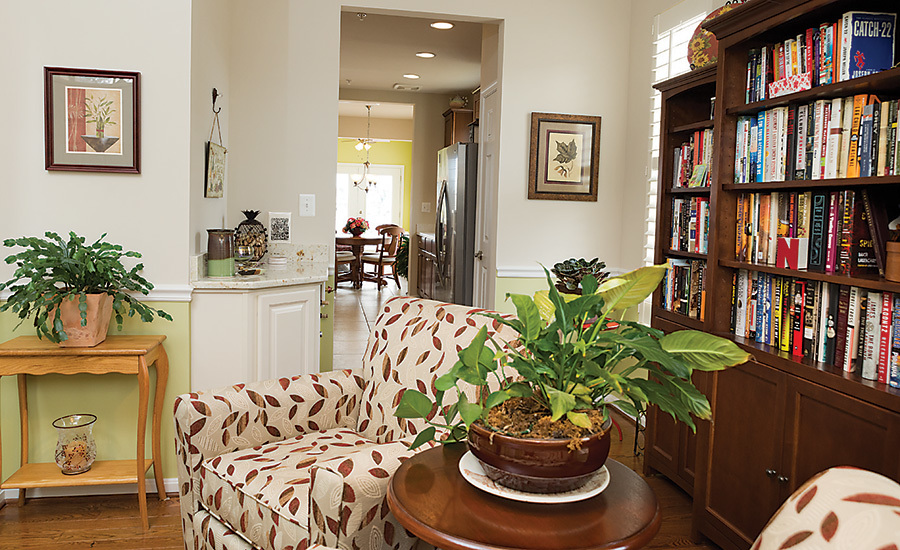
The Nawrots actually have more space in their three-bedroom, two-story townhouse than in their last home, which comes in handy when children and grandchildren visit.
The couple actually has more space in their three-bedroom, two-story townhouse than in their last home, which comes in handy when children and grandchildren visit. But despite the larger floor plan, they say they have fewer worries: “Here, it’s all maintenance-free outside, so we have nothing to take care of.” The amenities of condo-style living mean the Nawrots don’t have to worry about mowing the lawn or shoveling snow, but still have the space for grandchildren to play outside, for guests to stay over, and a large enough living and dining area to host parties.
At this stage in their lives—Ron still works full-time, while Robin has been retired for three years—Greenvale Mews allows the couple to minimize their worries and maximize their enjoyment of life, now and into the future.
Solution: Greenvale Mews
Cost: Attached villas start at $334,990
Fees: Condo/H.O.A. fee is $177 a month
The Pluses: Rural location adjacent to woods; fishing pond and walking trails; condominium-style living; easy access to Carroll County entertainment and attractions.
Footing The Bill
When we hear the word “downsizing,” we often think “saving money.” But usually, the opposite is true.Many retirees who choose to leave their longtime homes—where the mortgage was often low or may have been paid off—and move to a condo or retirement community face a significant increase in costs. Many seniors have responsibly stockpiled their savings in traditional routes—like cash, stocks, bonds, and maybe even real estate—to finance this extra expense when the time comes. However, “distortions in the market are greater today than during any other financial period, due to lower interest rates and a rotation to riskier investments, which has resulted in market volatility,” says Gregory Gann of Gann Partnership, a financial adviser with many clients at or near retirement. “The bull market since 2009 is exhausted,” says Gann. “Now, we’re seeing a period of investment that requires a completely different approach and strategy.” For those close to retirement, it’s a good idea to think about diversifying their approach, he says, and looking beyond stocks and bonds. “I have a client moving to Broadmead,” says Gann. “Before she decided, she took her money out of the market into cash because she didn’t want to see a correction.” One potential area for investment is the market-linked bond, says Gann. These types of investments appeal to those risk-averse people looking to increase their income and protect their portfolios from the market’s volatility. |
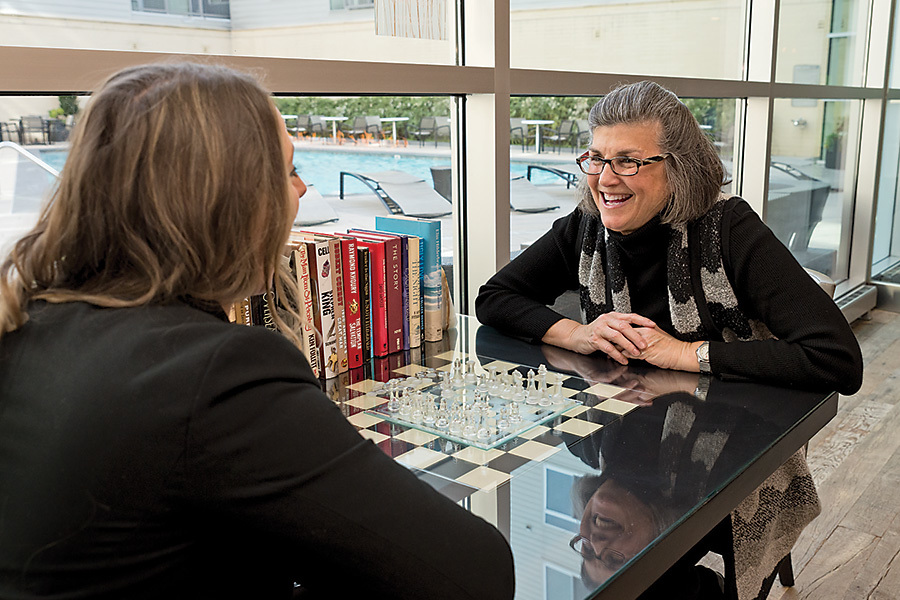
Returning to a New Baltimore
In 2010, retired brokerage executive Jackie Noller started thinking about leaving her rural home on Maryland’s Eastern Shore and returning to Baltimore—she had lived in its suburbs many years prior. “Where I was, there was no culture, and even though I could certainly get to New York City or D.C. by bus or train, it was a major event to do that,” she explains.
During her frequent trips to the city, Noller noticed a new complex, The Fitzgerald, a high-end development being constructed in Mt. Vernon near Penn Station, just off the Jones Falls Expressway. “In my years of living in Baltimore, this part of town wasn’t known for residential, cutting-edge architecture, so that attracted me first,” she says. “But mostly it was access to culture.” The Fitzgerald’s centralized location near cultural opportunities like concerts at the Joseph Meyerhoff Symphony Hall and the Lyric Opera House, independent films at the Charles Theatre, and lectures at the Maryland Institute College of Art and The Johns Hopkins University—not to mention light-rail access to the stadiums and the airport—persuaded Noller to rent a two-bedroom unit in 2012.
The Fitzgerald’s studio, one-, and two-bedroom apartments for rent attract a diverse community of residents, like graduate students, med school residents, and professionals who commute to D.C., says Noller. “I’m on the older end of the age range, but there are more people my age coming in now,” she says. Noller enjoys reading a book on the patio of the outdoor pool, or renting one of the well-equipped conference rooms for her charity activities. At the end of the day, though, what really makes a difference is the staff. “Their whole attitude is, ‘How can we make your day better?’”
Her current apartment is radically smaller than her prior homes, but Noller was happy to downsize.
Her current apartment is radically smaller than her prior homes, but Noller was happy to downsize. “I wanted to have a more simple life. I wanted to get rid of stuff and not have the maintenance issues that caused headaches and were really costly.” Since her apartment doesn’t have much room for storage, she forced herself to pare down even more. “I said, ‘If I don’t use it, I don’t need it’—and it’s true.” Her top-floor unit overlooks Penn Station, “which lights up at night like a Grecian temple,” she says. A newly constructed University of Baltimore law school building to the east casts a warm late afternoon glow across her open living room and kitchen from its reflective windows. And a just-the-right-size balcony gives Noller enough room to comfortably sit and read a book, providing that indoor-outdoor space often missing from an urban dwelling.
Although she doesn’t have the investment equity that homeownership provides, the 67-year-old sees several benefits to renting, like flexibility. “There’s a certain time and place where not owning makes sense. I’m not ready for a retirement community where I have the nursing home based inside of it, but I was ready to give up on the pleasures of the cookout in my own backyard in return for getting rid of the other burdens of maintaining a house.”
Solution: The Fitzgerald at UB Midtown
Cost: One-bedroom rentals start at $1,625/month.
Fees: Residents pay their own water, sewer, and electric. Parking is available for an additional $125/month.
The Pluses: 2,000-square-foot fitness center and yoga studio; three distinct, stylish lounges complete with a fireplace, billiard table and bar; outdoor swimming pool and water wall courtyard; business center equipped with Mac and PC computers; meditative courtyard with water and fire elements; conference facilities; movie theater with projector and comfortable seating; full-service concierge; pet-friendly community; parking garage with direct access to all floors and two EV car charging stations; fenced-in dog park.
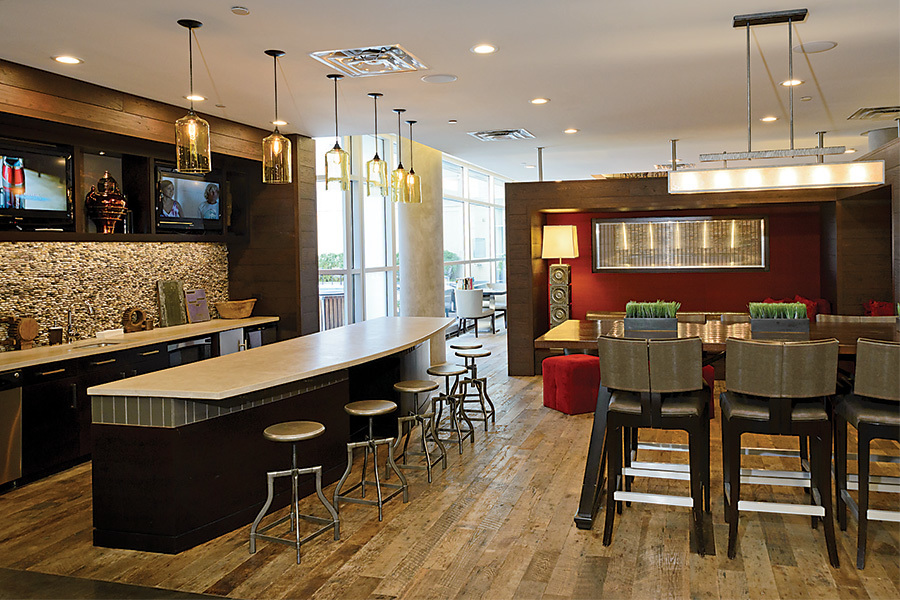
Among the amenities at The Fitzgerald are stylish lounges complete with a fireplace, billiard table, and bar, as well as a business center and conference facilities.
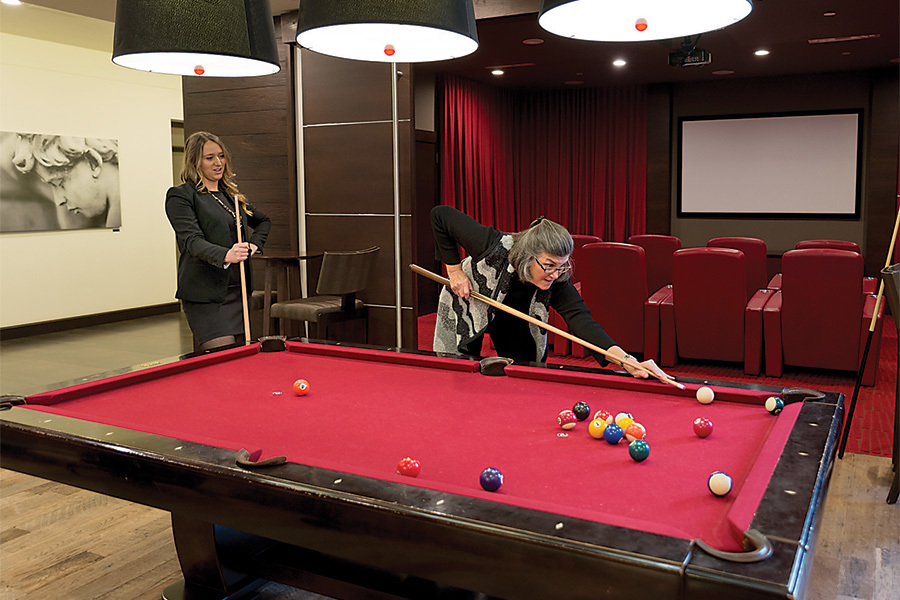
Noller tries to put one in the corner
pocket in The Fitzgerald’s game room. The Fitzgerald’s studio, one-, and two-bedroom apartments attract a diverse community of residents,
like graduate students, med school residents, and professionals who commute to D.C.
Living in Luxury
For J.R. and Martha Kirkland, the decision to move from their home in Potomac to the Ritz-Carlton Residences in Baltimore’s Inner Harbor was a calculated one. Retired and in their 70s, the couple was ready to let go of the burdens of their home, and to start a new chapter in their lives. “We had a large house and large lawn,” says J.R. Kirkland “The kids were gone and it took a lot of effort and energy to maintain the place as it should have been, so we decided to downsize. And we thought, if we’re downsizing, we’re going to move.” So the Kirklands made a list of what they were looking for in a new environment, like world-class health care, access to local and international transportation, walkability, a rich cultural heritage, and a classy place to live. Downtown Baltimore met all the criteria.
“It’s like moving from the Forest Lawn Cemetery to Disney World—there’s something going on all the time.”
“We could not be more pleased,” says Kirkland. “It’s a vibrant place. We moved from staid old Potomac, with big lots and big houses, to the Inner Harbor. I told one friend of mine that it’s like moving from the Forest Lawn Cemetery to Disney World—there’s something going on all the time.” From their balcony overlooking the American Visionary Art Museum, the Kirklands are in the middle of a multitude of events throughout the year, from parades and races to fireworks and concerts.
Although their two-bedroom, 2,200-square-foot condo is less than half the size of their prior home, living has felt “much less restrictive than I thought,” Kirkland says. “The space in our old home where we spent 80 percent of our time was about the size of our two-bedroom condo here,” he explains. And in addition to their unit, the Kirklands enjoy the Ritz-Carlton’s top-notch amenities at no additional cost, including a 24-hour concierge, a well-equipped fitness center, an indoor pool, a lounge, and a billiards room. Even extra rooms at the Residences can be reserved for visiting guests.
The couple worried that moving to an apartment would be impersonal, but they found just the opposite. “This is a very dog-friendly environment—there must be 75 dogs that live here. So all of us go out and walk our dogs and we immediately make friends,” he laughs. They were also happy with the community’s professional and ethnic diversity, adding that it has been easy to find common interests.
“There’s an affinity for going out to restaurants, going to the symphony, and so forth. So we have groups of people that get together and go out just because of the interactive nature of the community,” says Kirkland.
And the Ritz-Carlton service has lived up to its reputation. “It’s almost like an assisted-living environment but with no walkers and no aging people who have to eat dinner at 4 o’clock,” Kirkland says with a chuckle. “Almost every one of our desires, wants, and whims are taken care of.”
Solution: The Ritz-Carlton Residences, Inner Harbor, Baltimore
Cost: One-bedroom units start at nearly $500,000.
Fees: Association dues include all amenities plus gas, and are $0.85/square foot.
The Pluses: Indoor pool and spa; game and billiards room; film-screening room; meditation garden; workout facility and yoga room; more than 3 acres of green space and courtyards; valet parking; 24-hour concierge service.
Opting For A CCRC
Nancy-Bets Hay is a 74-year-old, second-generation resident of Broadmead, a continuing-care retirement community (CCRC) in the rolling hills of Cockeysville. “My parents had moved here when it first opened in 1979, so I watched them live the rest of their lives here with access to different levels of care and get what they needed, be well-cared-for, and be very happy.”It was that firsthand experience that inspired Hay—a former oncology social worker—and her husband, Erroll, to make the move to independent living sooner rather than later. “I might be a little more aware that I’m mortal than a lot of people,” she says with a smile. Although they moved to Broadmead for peace of mind, what really surprised the couple was how they would embrace the community. “We’re both very involved with a lot of activities here,” says Hay. Moving to a CCRC before you need the additional health care services is a good idea for many reasons. For one, younger, healthy retirees have the energy to tackle the daunting task of downsizing more easily. For seniors who can afford them, CCRCs are attractive because they offer different scales of care, from independent living to assisted living and nursing home levels. Joining a CCRC involves paying a one-time entrance fee and then monthly fees depending on the size of the unit and type of health care contract. There are traditionally three, sometimes four, types of contracts available when joining a CCRC, but not all CCRCs offer every type of contract. Type A contracts, often called extensive or life contracts, offer all-inclusive care including assisted living and health services at little or no extra fee. Type B contracts, often called modified contracts, are similar to Type A in that many services are included in the monthly fee, but excluded services are paid for at current market price on an as-needed basis. Type C “fee-for-service” contracts offer a lower initial enrollment fee, but residents must pay current market rate for any needed health care services. |
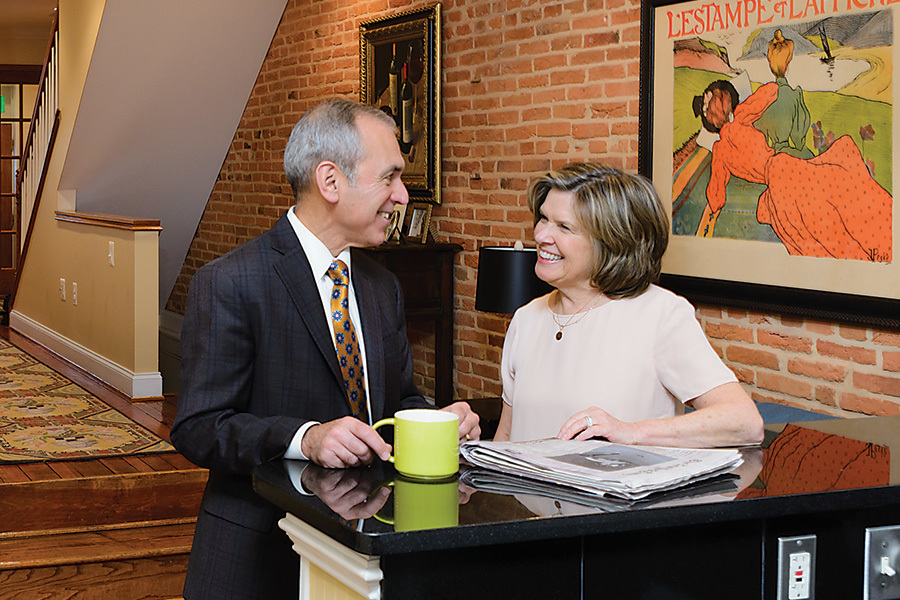
Empty Nester to Neighborhood Activist
From her bright and spacious three-bedroom rowhouse on Hanover Street in Federal Hill, Amy Mutch remembers how eager she and her husband, Patrick, were to move to the city. As soon as their youngest looked about ready to move out, Mutch says, the couple was on the starting blocks to leave suburban Ruxton for a neighborhood that allowed a more urban lifestyle.
“Our son was a sophomore in college when we moved—that’s how excited we were about living downtown,” Mutch remembers with a chuckle. “We’re still very much employed—retirement isn’t really in Patrick’s vocabulary,” says Mutch, who works part-time as a nurse practitioner and whose husband works full-time in health care management. “For us, it was more the downtown lifestyle, giving up maintaining a yard, and things like that, because we didn’t have the kids to consider.”
In their previous home, even small errands or short trips required driving. “You couldn’t really walk anywhere or ride your bike anywhere, it’s not set up that way,” she says. “So walkability, for me, was the biggest improvement with the move. I love not having to get in my car for every single errand.” Now, Mutch can walk or ride her bike to most places she needs to go—from the bank and the dry cleaner to Orioles and Ravens games and local restaurants.
Since the Mutches moved in 2004, they’ve enjoyed no longer having to maintain a large yard or shovel snow. By purchasing a rowhouse on a long lot, they have the convenience of a two-car garage, plus a roomy patio and roof decks mean they haven’t given up outdoor space. The rowhouse’s narrow layout did present some decorating challenges, though. When it came time to move, most of the family’s current furniture didn’t work in the confines of their new home. “That was very surprising to me—I did have to get a lot of new furniture,” she remembers.
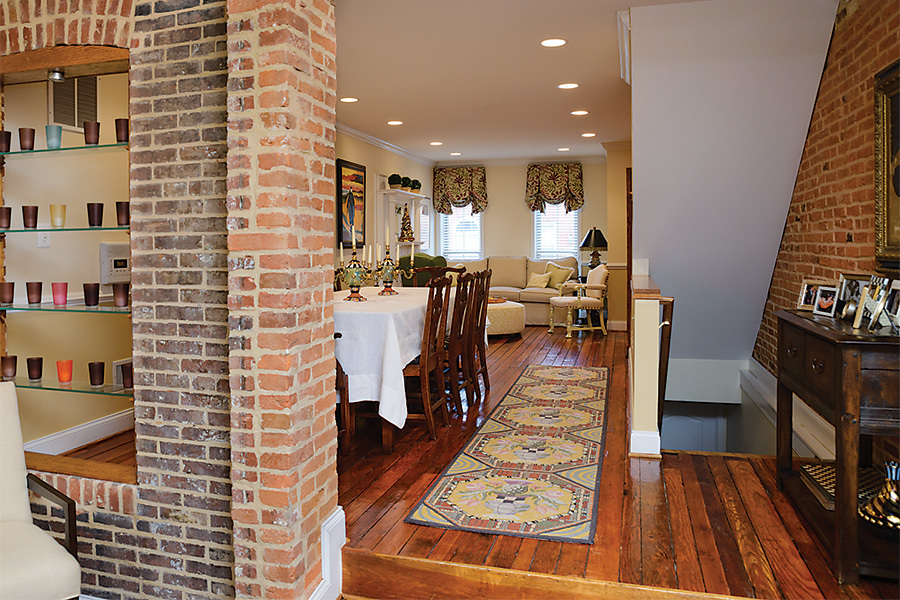
The rowhouse’s narrow layout did present challenges, though. When it came time to move, most of the Mutches’ furniture didn’t fit.
Another change for the couple was the close proximity to neighbors. “The biggest adjustment in rowhouse living is you need to know your neighbors and work with them,” she says. “When you have a big house in the county, you don’t think too much about it.” But Mutch did more than just adjust: Before long, she found herself attending zoning board meetings and becoming active in the neighborhood association. “It was a surprise, but these zoning board issues very much affected how I was going to enjoy my home and how I would live,” she says. Mutch discovered a passion for community work, eventually becoming president of the Federal Hill Neighborhood Association. (She also served as South Baltimore Neighborhood Association president.)
Twelve years in to rowhouse living, the Mutches have no plans to move. “We’re fortunate that Federal Hill made so much sense for us. It’s been great,” she says. “Plus, once you’ve lived here for a while, it becomes your favorite neighborhood. I love it.”
|